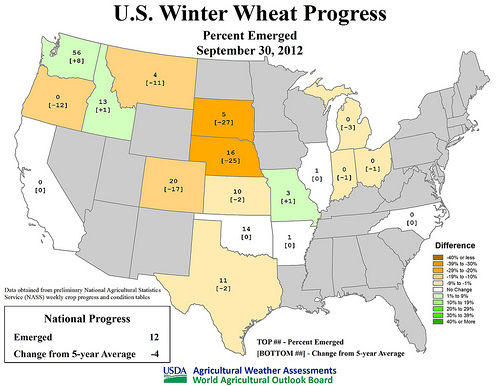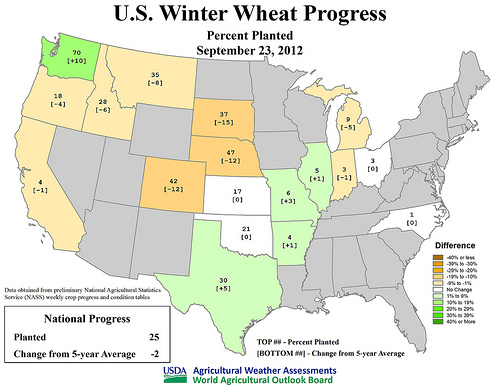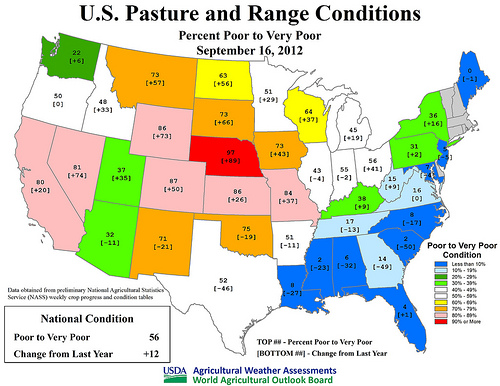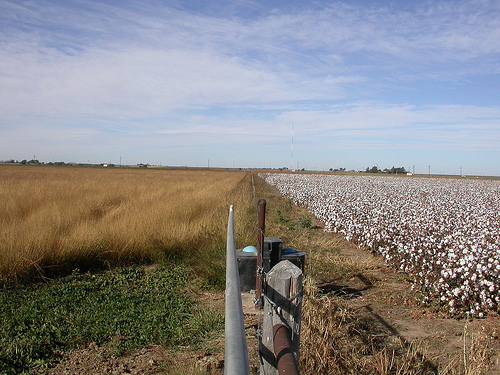
U.S. Winter Wheat Progress, October 14, 2012. (Click to enlarge image.)
Visit www.usda.gov/drought for the latest information regarding USDA’s Drought Disaster response and assistance.
According to the latest U.S. Drought Monitor, valid October 9, nearly two-thirds (63.55%) of the contiguous U.S. remains in drought. However, this is down nearly two percentage points from the late-September peak of 65.45%, as recent rains across the South and East have chipped away at the drought. At the same time, drought continues to gradually intensify across the northern Plains, where rangeland and pastures remain in dismal condition and winter wheat emergence has been hampered by a lack of soil moisture. Read more »
This post is part of the Science Tuesday feature series on the USDA blog. Check back each week as we showcase stories and news from USDA’s rich science and research profile.
Organic agriculture is proving itself to be a veritable cornucopia, according to the results of the first-ever report on certified USDA organic production, which we released earlier this month. While the number of organic farms is a fraction of its conventional counterpart, an organically produced version of virtually every crop or animal product is now available in the United States.
This was the first time the National Agricultural Statistics Service (NASS) conducted this survey, which means that we cannot see trends yet, but we can already easily see some of the impacts of organic production in the United States. From four farms in Alabama, Alaska or Delaware to 1,898 farms in California, every state in the nation is now home to USDA-certified organic producers. And while these farmers make up less than a half of one percent of all U.S. farmers, they already sell more than $3.5 billion worth of agricultural products. Read more »

U.S. Winter Wheat Progress - Percent emerged September 30, 2012. Click to enlarge image.
Based on data since 1995, U.S. corn and soybean harvests are proceeding at a record pace. By September 30, 2012, more than one-half (54%) of the corn had been harvested, nearly three times the five-year average of 20%. During the preceding 17 years, the record amount of U.S. corn harvested by the end of September had been 35% in 2000. Similarly, 41% of the soybeans had been harvested by September 30. Prior to this year, the record-setting soybean harvest pace by September 30 had also been 35% in 2000. Read more »

U.S Winter Wheat Progress - Percent Planted as of September 23, 2012
Visit www.usda.gov/drought for the latest information regarding USDA’s Drought Disaster response and assistance.
Based on data since 1995, U.S. corn and soybean harvests are proceeding at a record pace. By September 23, more than one-third (39%) of the corn had been harvested, three times the five-year average of 13%. During the preceding 17 years, the record amount of U.S. corn harvested by September 23 had been 24% in 2000. Similarly, more than one-fifth (22%) of the soybeans had been harvested by September 23. Prior to this year, the record-setting soybean harvest pace by September 23 had been 18% in 2000. Read more »

U.S. Pasture and Range Conditions as of September 16, 2012. Click to enlarge image.
The 2012 summer crop season is quickly winding down. By mid-September, more than three-quarters (76%) of the U.S. corn was fully mature and well over half (57%) of the soybeans were dropping leaves, according to USDA’s National Agricultural Statistics Service. More than one-quarter (26%) of the corn had already been harvested by September 16, a record-setting pace. As the growing season comes to an end, corn and soybean conditions (currently 50% and 36% very poor to poor, respectively) remain comparable to those observed during the 1988 drought. Read more »

Grass and cotton fields in the Texas High Plains study. Credit: Vivien Allen (Texas Tech University).
This post is part of the Science Tuesday feature series on the USDA blog. Check back each week as we showcase stories and news from USDA’s rich science and research profile.
Words like eco-friendly, green, fair, climate-friendly, community-based and organic are popping up daily – in the news, in ads and labels, and in conversations ranging from kitchen tables to international conferences. All of these and more come under the umbrella of sustainability, which people often describe as caring for people, planet and proceeds all at the same time. Read more »





